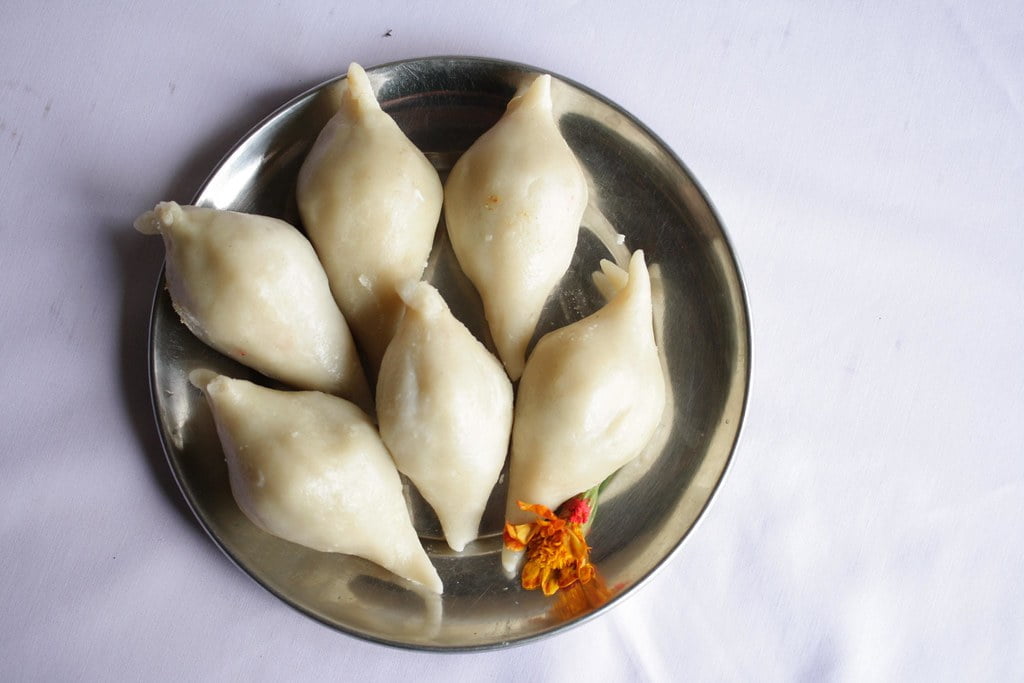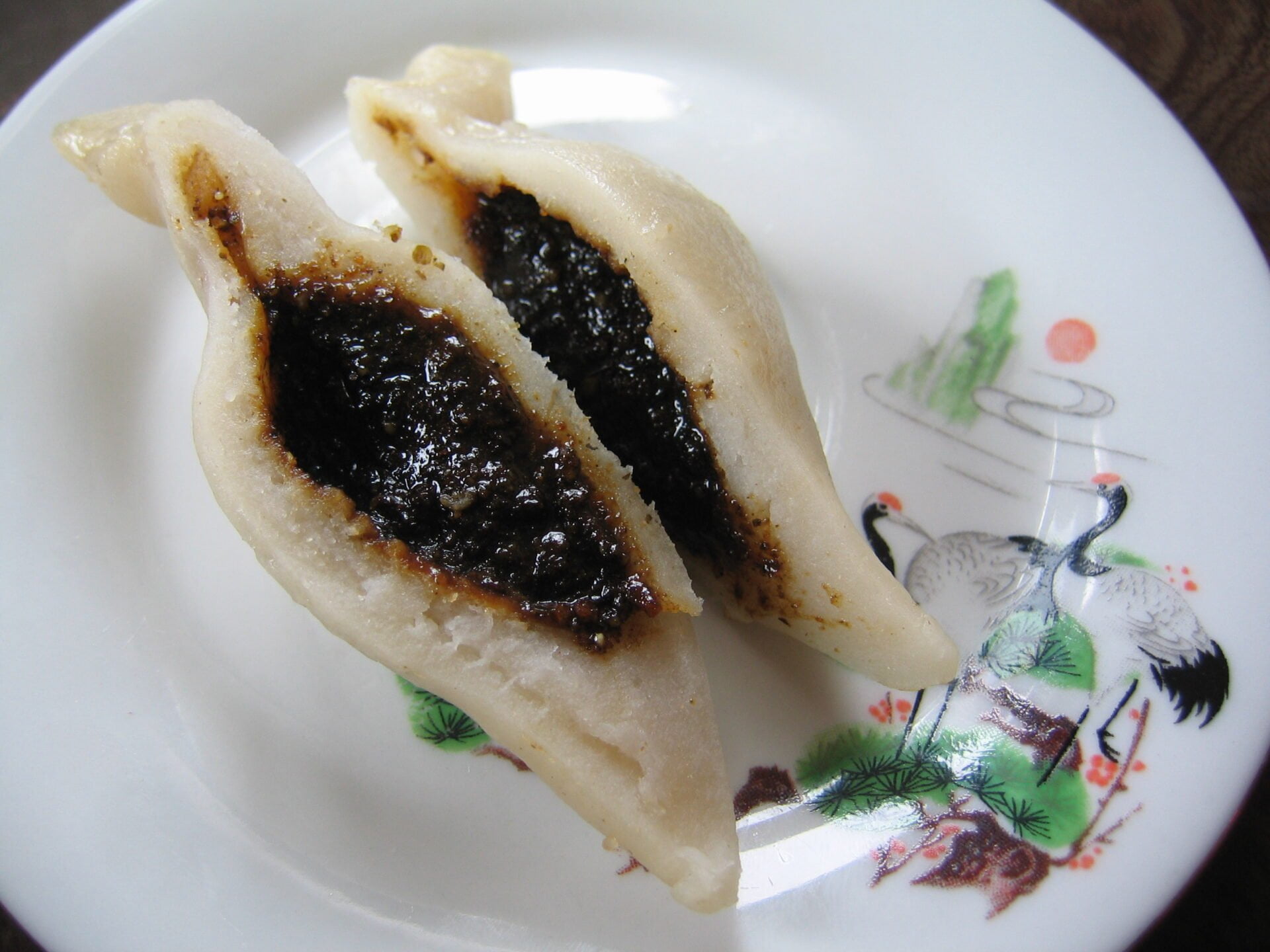Yomari
The origins of Yomari, a unique and traditional Newari delicacy, can be traced back to the town of Panauti in the Kathmandu Valley of Nepal. Yomari is a type of steamed rice flour dumpling filled with brown cane sugar (chaku/molasses) and sesame seeds, although some people use khuwa instead of chaku. The most common shape of Yomari is that of a fish.
There are several stories surrounding the origin of Yomari, all of which contribute to the rich folklore and cultural significance of this delectable treat. One legend states that a couple in Panauti first made Yomari and shared it with their neighbors, who instantly fell in love with its taste. This is believed to be the reason behind the name “Yomari,” with “Yo” meaning love or favorite, and “Mari” meaning bread.
According to another story, the god of wealth, Kuber, disguised himself as a beggar and visited Panauti. The couple who made Yomari generously offered some to the beggar, and Kuber was greatly impressed. To show his gratitude, Kuber shaped the Yomari into the form of gods and goddesses, symbolizing wealth, on the full moon day. From that day onwards, the Yomari Punhi festival started, and it continues to be celebrated with great enthusiasm by the Newar community.
Historians have debated the origins of Yomari, suggesting that the Newars might have learned how to make it from Tibetans, who, in turn, learned the skill from Koreans. Another theory proposes that Yomari is based on the Indian sweet called Modaka. Modakas are rice flour dumplings filled with jaggery and coconut, similar to Yomaris. They are traditionally prepared during the Hindu festival of Ganesha Chaturthi, and Ganesha is believed to have a fondness for Modakas. Hence, the name Yomari could mean the favorite bread of Ganesha.
Cultural and Religious Significance
Yomari Punhi, a festival celebrated by Nepali communities, holds immense cultural and religious significance. This festival is a time when people come together to honor their traditions, express gratitude, and celebrate the abundance provided by the harvest.
In Hinduism, Yomari Punhi is associated with the goddess Annapurna, the deity of food and nourishment. Devotees gather at various temples, particularly the Annapurna Temple in Kathmandu, to offer prayers and seek blessings for a bountiful harvest and prosperity. The sweet Yomari dumplings, made from rice flour and filled with molasses, are then offered to the goddess as a symbol of gratitude for the abundance provided by the harvest. By offering Yomari to Annapurna, people show their appreciation for the sustenance they receive from the land.
Beyond its religious significance, Yomari Punhi is also a celebration of cultural diversity in Nepal. The festival brings communities together, reinforcing the bonds of kinship and friendship. Traditional music, dance, and cultural performances are a common sight during the festivities, showcasing the rich heritage of the Nepali people.
Yomari Punhi is not just about the enjoyment of festive sweets; it is deeply rooted in the history, beliefs, and way of life of the Nepali people, particularly the Newa community. The tradition of making Yomari with chaku (molasses) and khuwa (reduced milk) may have originated within the Newa culture, although its exact origins are uncertain. However, what is certain is that Yomari and chaku hold a special place in the culinary traditions of the Newa people and are considered culinary delicacies that define their food culture.
The festival of Yomari Punhi serves as a reminder of the importance of preserving and celebrating traditional practices. It is an opportunity for reflection, gratitude, and the sharing of joyous moments with loved ones. As Nepali communities come together to celebrate Yomari Punhi, they embrace the spirit of unity, cultural heritage, and the sweetness that this festival brings into their lives.

Ingredients and Preparation
Yomari Punhi, a traditional sweet delicacy from Nepal, is made using a few simple ingredients and a careful preparation process. Here is a step-by-step guide on how to make this delectable treat:
Ingredients:
- 2 cups of rice flour
- 1/3 cup of all-purpose flour
- 2 cups of jaggery (or molasses or palm sugar)
- 1 tablespoon of sesame seeds
- 2 tablespoons of ghee (clarified butter) or oil
- 1/2 cup of milk
- 1/2 cup of warm water
Preparation:
- Preparing Dough:
- In a bowl, combine the rice flour and all-purpose flour. Mix well.
- Gradually add warm water to the flour mixture while kneading it to make a soft dough.
- Once the dough is well-kneaded, cover it and set it aside to rest for about 10 minutes.
- Preparing the Filling:
- Heat a saucepan over high temperature and add the jaggery (or molasses or palm sugar).
- Add the sesame seeds to the saucepan.
- Stir continuously with a spoon to prevent burning and let the jaggery melt completely.
- Add a little milk to the mixture and stir for another minute.
- Remove from heat and allow the filling to cool.
- Shaping the Yomari:
- Take a small portion of the dough and flatten it in the palm of your hand.
- Place a spoonful of the jaggery filling in the center of the flattened dough.
- Carefully fold the edges of the dough over the filling, sealing it in a crescent shape. Make sure the filling is completely enclosed.
- Steaming the Yomari:
- Prepare a steamer by boiling water in a pot or using a steamer basket.
- Place the shaped Yomari in the steamer, making sure they are not touching each other.
- Steam the Yomari over medium heat for about 12-15 minutes, or until they become soft and cooked.
Once cooked, the Yomari can be served hot or at room temperature. They are often enjoyed as a dessert during festivals, weddings, or special occasions. The combination of the soft outer dough and the sweet, flavorful filling makes Yomari a delightful treat for both the eyes and the taste buds.
In addition to the traditional recipe, variations of Yomari can also be found, such as the Frozen Yomari Chicken offered by Kathmandu Momocha in Washington State. These variations add a unique twist to the traditional recipe, catering to different preferences and tastes.
Whether you decide to try the traditional Yomari recipe or opt for a modern twist, this Nepalese delicacy is sure to leave you craving for more. So, gather the ingredients, follow the preparation steps, and indulge in the delightful flavors of Yomari Punhi.

Sweet Filling and Variations
The traditional filling, known as “khuwa,” is made from condensed milk and is renowned for its rich and creamy texture. It provides a delightful contrast to the soft and chewy rice flour covering of the yomari. The khuwa filling is considered a classic and is loved by many.
However, in recent years, innovative variations have emerged, offering exciting new flavors and fillings. Some popular sweet fillings include chocolate, caramel, nutella, and even exotic fruit flavors such as mango and passionfruit. These variations have added a contemporary twist to the traditional delicacy, appealing to a younger generation and expanding the culinary possibilities of the yomari.
In addition to the sweet fillings, there have also been creative variations in the presentation of yomaris. While the traditional yomari is shaped like a triangle, some modern adaptations feature different shapes such as hearts, stars, or even animal designs. These visually appealing yomaris not only taste delicious but also add a playful and artistic element to the festival.
The introduction of these sweet fillings and variations has helped to keep the Yomari Punhi Festival relevant and exciting in changing times. It has allowed for the preservation of tradition while embracing innovation. The blend of old and new ensures that the festival remains a vibrant and culturally significant celebration for the Newar community.
Whether it’s the classic khuwa filling or the more adventurous chocolate or fruit flavors, yomaris with their delectable sweet fillings and variations continue to captivate the taste buds and hearts of people during the Yomari Punhi Festival. The festival serves as a reminder of the rich culinary heritage of the Newar community and showcases their ability to adapt and innovate while staying rooted in tradition.

